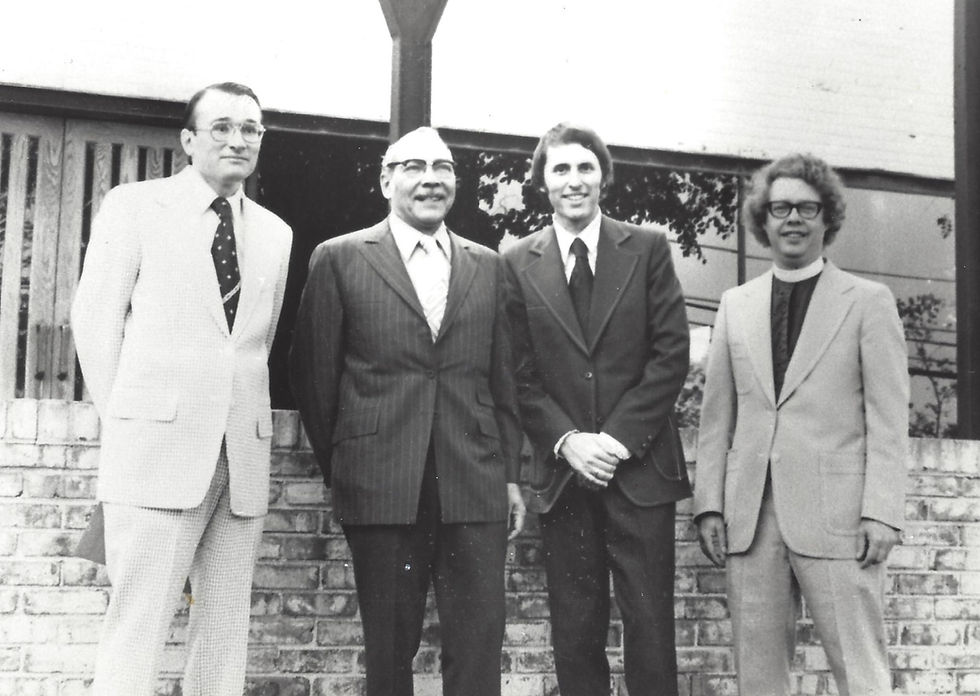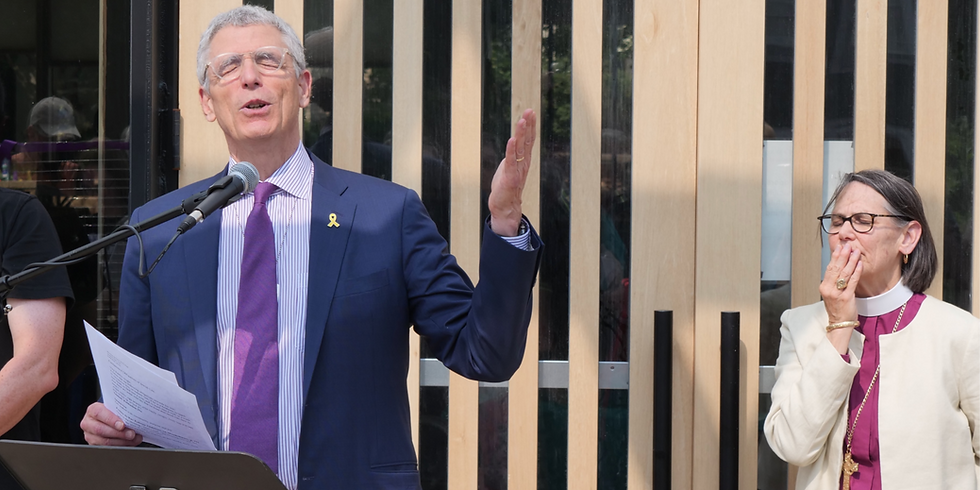The Founding of Genesis of Ann Arbor
- Genesis of Ann Arbor
- Oct 28, 2024
- 7 min read
In continuation of our celebration of our 50th Anniversary, Genesis invited our first President, Bob Creal, to share his reflections on the founding of Genesis of Ann Arbor.

As a member of the team that negotiated what ever since has been know as the Genesis Agreement, the author of the Agreement and the first President of Genesis of Ann Arbor, I was requested to recount the events which ended up bringing together a Christian parish and a Jewish congregation to own and share common worship facilities and a unique relationship. This is my recollection.
— Robert B. Creal, June 2024
How did this all come about?
On December 17,1974, the consent of the Bishop of the Episcopal Diocese of Michigan, the Right Reverend H. Coleman McGhee, was affixed to the Agreement between St. Clare of Assisi Episcopal Church of Ann Arbor and Temple Beth Emeth, thus completing the creation of the entity since known as Genesis of Ann Arbor. This was followed on December 23, 1974, with its incorporation with the State of Michigan.
As Genesis of Ann Arbor is basically an entity owning and maintaining real and personal property jointly used by its two member religious corporations, a brief pre-Genesis history of the piece of property at the corner of Packard Road and Eastover Place in Ann Arbor, I believe, is appropriate to place this joint relationship into its historical context.
The Property
This Packard Road real property was purchased by area pioneer John Anderson in 1831 and remained owned by his descendants for the next 100+ years. In 1846, the Greek-Revival house still standing on the property was constructed by John’s son, then County Sheriff, William Anderson. In 1937, the property was purchased by Dr. Inez Wisdom, a noted Ann Arbor physician and a prominent member of the Episcopal Church, who with her companion, Gertrude Griffith, occupied the home until their respective deaths.
In 1941, the small chapel was constructed by Dr. Wisdom (which she named the St. Francis Chapel) for private prayer. She eventually invited and was joined by other Episcopalians in worship which led to the formation of a mission church named St. Clare of Assisi Episcopal Church. With a growing mission membership and the financial assistance of the Episcopal Diocese of Michigan, a two-level block structure was built in 1956 and occupied as the St. Clare worship facility. Over the next 12 years, the St. Clare mission parish grew to where it became a full independent parish and incorporated in 1965 as a Michigan religious corporation. It then began planning for a new worship facility to accommodate its still growing membership.
Construction of the new worship structure began in 1967 and was completed in the late summer of 1968. The first worship service in the new sanctuary was held on September 28, 1968.
The Temple Lease
Obviously, this new place of worship became known and recognized outside the Episcopal community because in early 1969, St Clare’s Rector, Rev. Colin Campbell, was approached by Bruce Warshal, the Rabbi of the recently founded Reformed Jewish congregation, Temple Beth Emeth, who asked if St Clare would be interested in renting its new church for use by the Temple on Friday evenings for its worship services. Rev. Campbell took this inquiry to the St. Clare Vestry, which, after consideration, agreed to the Temple’s request. As the Senior Warden of St. Clare at the time, I was appointed to meet with the Temple’s representative, Allyn Kantor, a fellow attorney, to negotiate a rental agreement. We met and in short order had a one-page agreement providing for rent equal to one month’s St Clare mortgage payment per year plus one-seventh of St Clare’s monthly utility payments. Temple Beth Emeth began use of the facility shortly thereafter. Thus began the relationship between St. Clare and Temple Beth Emeth.
During the next five years Temple Beth Emeth held its weekly services in St Clare’s sanctuary on Friday evenings, but conducted its administrative and education activities elsewhere.
During this time the Temple also invited St. Clare’s congregants to join in annual Peace Seders conducted at various locations capable of handling large numbers, which with other contacts provided opportunities for members of both congregations to become better acquainted and socialize on a friendly basis.
Let’s Do It
In February or March, 1974, St. Clare’s new Rector, Rev. Douglas Evett was approached by Rabbi Warshal with a significant question: "Would St. Clare be interested in selling a half interest in it’s facilities to Temple Beth Emeth thus becoming joint owners?" The Temple had grown greatly in numbers and desired to establish a permanent home for its religious activities, preferably remaining on site or, if that was not possible, going elsewhere.
As I had only recently been again elected Senior Warden, I received a call from Doug Evett asking to meet in his office. When we met Doug explained his meeting with Bruce and asked my thoughts on such a proposition. After a moment of quick thought, I replied: "Let’s do it !"
As it was assumed that the idea of acquiring an ownership interest in its present place of worship had already been discussed and approved by the Temple Beth Emeth congregation, leadership and Rabbi, an informal meeting was set and held between Temple leader, Paul Vanek and myself on behalf of St. Clare. Paul explained the Temple’s desire to have a permanent home for its religious activities, its desire, if possible, to remain where it had regularly been worshipping, how it believed this could be accomplished, and how it believed such would affect St. Clare.
With this information, an early meeting of the St Clare Vestry was called to discuss this rough proposal and determine whether or not and how to proceed further. When the Vestry met, a considerable discussion resulted in a generally favorable response to the Temple’s general proposal. However, as such a matter did not lie within the power of the Vestry alone, the decision was made to initiate a two phase procedure for the entire congregation to decide whether or not to accept this proposal. First, the congregation needed to discuss and determine whether or not it was willing to relinquish its sole ownership of its religious facilities to a joint ownership with Temple Beth Emeth. And then, if approved by the St. Clare congregation in concept, negotiating and approving a detailed agreement with the Temple. Thus, the approval process began.
Phase One: The Concept
Over the next couple of months discussions both formal and informal were held by the members of St. Clare in large and small numbers. Pros and cons were expressed. Everyone with a view was given an opportunity to express it and to consider and contemplate the views of fellow congregants. In June, a formal meeting of the St. Clare congregation was held, and a vote taken resulting in an overwhelming approval of the concept of joint ownership of the religious facilities with Temple Beth Emeth.
Phase Two: Negotiations
With the approval of the “concept” by the congregations in hand, phase two of the process began.
At its next meeting, the Vestry appointed three of its members to negotiate an agreement with representatives of the Temple, and the Temple Board did the same. St Clare’s representatives were myself, as Senior Warden, Steve Bostwick, Junior Warden, and Carolyn Witcher as Vestry member. The Temple representatives were Board President Stephen Young, Dr. Gilbert Small and Sheldon Berry.
Over the next two or three months the negotiating committee met several times in members' living rooms discussing various elements of what a joint entity should be. Early in the committee’s first meeting, it was decided that whatever entity was to eventually evolve from our discussions for the time being needed a work name. It was suggested and agreed that instead of using the word "it," we use the name "C & J, Inc." until a permanent name was selected.
Meetings of the committee were friendly, congenial and productive. Topics of discussion included C & J inc. structure, governance, property management and maintenance, sanctuary changes, building changes, exterior changes, financial considerations, anticipated new construction and the use of and responsibility for the Anderson-Wisdom home and the St. Francis chapel (which were retained exclusively by St. Clare). All subjects agreed upon by the committee, as we went, were referred to the Vestry and Temple Board for discussion, consideration, and proposed changes, if any.
Once the major decisions had been agreed upon by the committee and governing boards, the committee agreed to the one suggestion for the permanent name of the new entity: "Genesis of Ann Arbor."
As the only attorney on the negotiating committee, I volunteered to draft an agreement incorporating all the elements of the agreed discussions for the consideration and approval of the committee, the two governing boards and the congregations.
The Agreement
Believing that something more than the basic terms of the agreement was necessary to explain the reasons for this new religious relationship, I independently decided to preface the Genesis Agreement with a statement as to why we were doing what we were doing. Back in a corner of the University of Michigan Law library, one weekday morning, I began writing what was to become the introduction to the Genesis Agreement, entitled "Preamble." The rest of the agreement provisions flowed from there. When finished, the draft document was submitted to the committee, tweaked, submitted to the Vestry and Temple Board for review and suggested changes, if any, and when finally approved by both, submitted to the respective congregations for final approval.
Approval
After final approval by the St Clare congregation in early December 1974, the last of the required approvals, Rev Douglas Evett and I met with the Diocesan Standing Committee, obtained its recommendation to the Bishop for approval by him, and then met with Bishop McGhee and obtained his enthusiastic approval and support.
Shortly thereafter, Articles of Incorporation for Genesis of Ann Arbor were filed with the State of Michigan thus officially creating the religious corporation, the founding of which we are now celebrating its 50th anniversary.
A First
With the formation of Genesis of Ann Arbor, it was believed that this was the first time a religious facility had ever been jointly owned by Christian and Jewish congregations. Also, the formation of Genesis made the national news, being reported on air by John Chancelor.




Comments